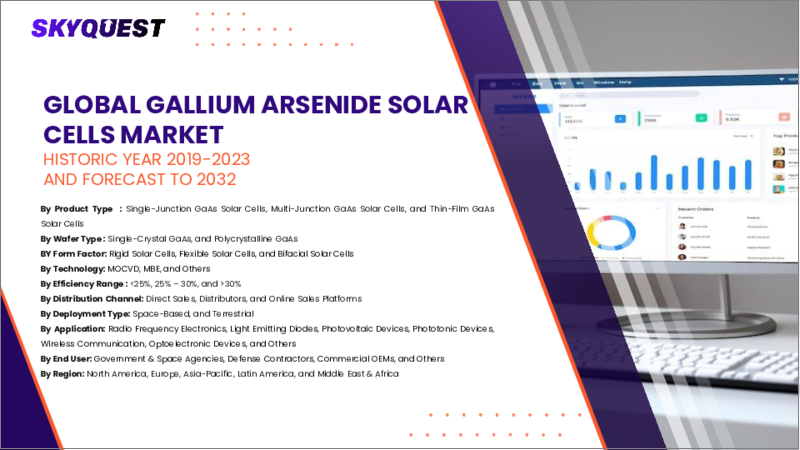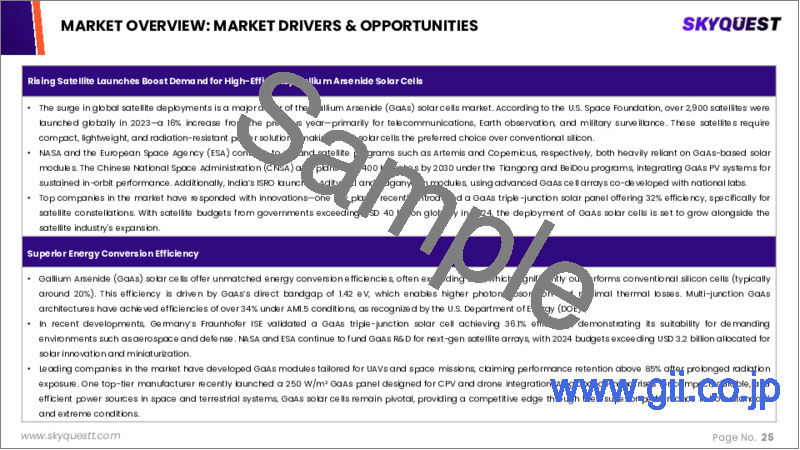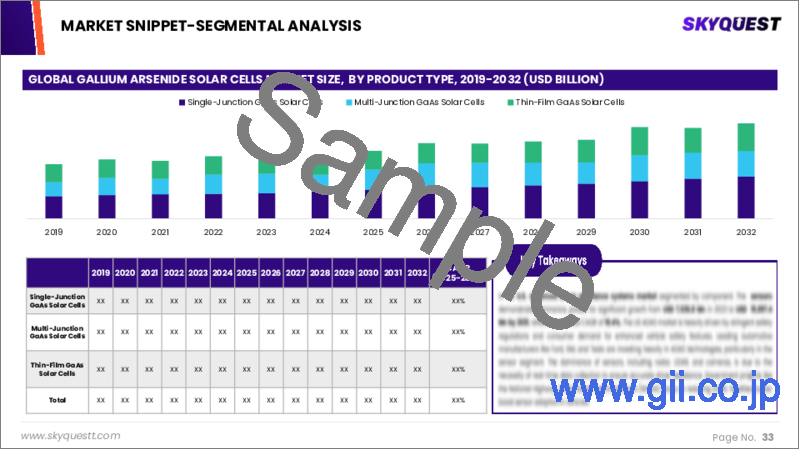|
|
市場調査レポート
商品コード
1663007
ガリウムヒ素太陽電池の市場規模、シェア、成長分析、タイプ別、用途別、エンドユーザー別、地域別 - 産業予測、2025-2032年Gallium Arsenide Solar Cells Market Size, Share, and Growth Analysis, By Type, By Application, By End-User, By Region - Industry Forecast 2025-2032 |
||||||
|
|||||||
| ガリウムヒ素太陽電池の市場規模、シェア、成長分析、タイプ別、用途別、エンドユーザー別、地域別 - 産業予測、2025-2032年 |
|
出版日: 2025年02月20日
発行: SkyQuest
ページ情報: 英文 182 Pages
納期: 3~5営業日
|
全表示
- 概要
- 目次
ガリウムヒ素(GaAs)太陽電池市場規模は、2023年に163億8,000万米ドルと評価され、2024年の177億7,000万米ドルから2032年には341億3,000万米ドルに成長し、予測期間(2025-2032年)のCAGRは8.5%で成長する見通しです。
ガリウムヒ素(GaAs)太陽電池市場は、従来のシリコン太陽電池に比べ、優れた効率と生産コストの削減により、大幅な成長が見込まれています。GaAs太陽電池は、航空宇宙、軍事、ニッチ家電市場などの高性能分野で主に利用されています。この分野の可能性を示すものとして、Alta Devices社は2021年1月、米国空軍から宇宙用軽量フレキシブル太陽電池の開発で710万米ドルの契約を獲得しました。さらに、Azur Space Solar Power社は2021年8月、30.3%という前例のない効率を達成したトリプル接合GaAsセルを開発し、記録を塗り替えました。これらの進歩は、高効率・多接合太陽電池用途に最適な基板としてのGaAsの重要性を強調し、市場拡大をさらに後押ししています。
目次
イントロダクション
- 調査の目的
- 調査範囲
- 定義
調査手法
- 情報調達
- 二次と一次データの方法
- 市場規模予測
- 市場の前提条件と制限
エグゼクティブサマリー
- 世界市場の見通し
- 供給と需要の動向分析
- セグメント別機会分析
市場力学と見通し
- 市場概要
- 市場規模
- 市場力学
- 促進要因と機会
- 抑制要因と課題
- ポーターの分析
主な市場の考察
- 重要成功要因
- 競合の程度
- 主な投資機会
- 市場エコシステム
- 市場の魅力指数(2024年)
- PESTEL分析
- マクロ経済指標
- バリューチェーン分析
- 価格分析
- ケーススタディ
- 技術の進歩
- 規制情勢
- 特許分析
世界のガリウムヒ素(GaAs)太陽電池市場規模:タイプ別
- 市場概要
- 単接合GaAs太陽電池
- 多接合GaAs太陽電池
ガリウムヒ素(GaAs)太陽電池の世界市場規模:用途別
- 市場概要
- 宇宙アプリケーション
- 地上アプリケーション
ガリウムヒ素(GaAs)太陽電池の世界市場規模:エンドユーザー別
- 市場概要
- 住宅用
- 商業用
- 産業用
- 公共事業
世界のガリウムヒ素(GaAs)太陽電池市場規模
- 北米
- 米国
- カナダ
- 欧州
- ドイツ
- スペイン
- フランス
- 英国
- イタリア
- その他欧州地域
- アジア太平洋地域
- 中国
- インド
- 日本
- 韓国
- その他アジア太平洋地域
- ラテンアメリカ
- ブラジル
- その他ラテンアメリカ地域
- 中東・アフリカ
- GCC諸国
- 南アフリカ
- その他中東・アフリカ
競合情報
- 上位5社の比較
- 主要企業の市場ポジショニング(2024年)
- 主な市場企業が採用した戦略
- 最近の市場動向
- 企業の市場シェア分析(2024年)
- 主要企業の企業プロファイル
- 企業の詳細
- 製品ポートフォリオ分析
- 企業のセグメント別シェア分析
- 収益の前年比比較(2022-2024)
主要企業プロファイル
- AIXTRON SE(Germany)
- Sumitomo Electric Industries, Ltd.(Japan)
- Hanergy Thin Film Power Group(China)
- Solar Junction(USA)
- Saint-Gobain Solar(France)
- JDS Uniphase Corporation(USA)
- Space Photovoltaic Research Center(Japan)
- NREL(USA)
- Sharp Corporation(Japan)
- Boeing Spectrolab(USA)
- MicroLink Devices(USA)
- IQE plc(UK)
- Freiberger Compound Materials GmbH(Germany)
- Xiamen Powerway Advanced Material Co., Ltd.(China)
結論と提言
Gallium Arsenide (GaAs) Solar Cells Market size was valued at USD 16.38 billion in 2023 and is poised to grow from USD 17.77 billion in 2024 to USD 34.13 billion by 2032, growing at a CAGR of 8.5% during the forecast period (2025-2032).
The Gallium Arsenide (GaAs) solar cells market is poised for substantial growth, fueled by their superior efficiency and decreasing production costs compared to conventional silicon solar cells. GaAs cells are predominantly utilized in high-performance sectors such as aerospace, military, and niche consumer electronics markets. Highlighting the sector's potential, Alta Devices secured a $7.1 million contract from the US Air Force in January 2021 to create a lightweight, flexible solar cell for space use. Additionally, Azur Space Solar Power broke records in August 2021 by developing a triple-junction GaAs cell that achieved an unprecedented efficiency of 30.3%. These advancements underscore GaAs's significance as an optimal substrate for high-efficiency and multijunction solar cell applications, further driving market expansion.
Top-down and bottom-up approaches were used to estimate and validate the size of the Gallium Arsenide (Gaas) Solar Cells market and to estimate the size of various other dependent submarkets. The research methodology used to estimate the market size includes the following details: The key players in the market were identified through secondary research, and their market shares in the respective regions were determined through primary and secondary research. This entire procedure includes the study of the annual and financial reports of the top market players and extensive interviews for key insights from industry leaders such as CEOs, VPs, directors, and marketing executives. All percentage shares split, and breakdowns were determined using secondary sources and verified through Primary sources. All possible parameters that affect the markets covered in this research study have been accounted for, viewed in extensive detail, verified through primary research, and analyzed to get the final quantitative and qualitative data.
Gallium Arsenide (Gaas) Solar Cells Market Segments Analysis
Global Gallium Arsenide (GaAs) Solar Cells Market is segmented by Type, Application, End-User and region. Based on Type, the market is segmented into Single-Junction GaAs Solar Cells and Multi-Junction GaAs Solar Cells. Based on Application, the market is segmented into Space Applications and Terrestrial Applications. Based on End-User, the market is segmented into Residential, Commercial, Industrial and Utility. Based on region, the market is segmented into North America, Europe, Asia Pacific, Latin America and Middle East & Africa.
Driver of the Gallium Arsenide (Gaas) Solar Cells Market
The escalating awareness of the detrimental impacts of non-renewable energy sources on the environment has significantly spurred the demand for renewable energy solutions, particularly solar energy. As a result, there is a notable shift towards the utilization of Gallium Arsenide (GaAs) solar cells, which are recognized for their exceptional efficiency and reliability. This increased focus on sustainable energy alternatives not only highlights the urgent need for environmentally-friendly power generation methods but also positions GaAs solar cells as a compelling choice in the renewable energy market, catering to both commercial and residential applications seeking higher performance.
Restraints in the Gallium Arsenide (Gaas) Solar Cells Market
While GaAs solar cells are often deemed environmentally sustainable, the process of producing gallium arsenide raises significant environmental issues. Specifically, the manufacturing of these cells can lead to the release of hazardous substances, which poses potential risks to both human health and the environment. These concerns highlight the need for careful management and mitigation strategies in the production process to ensure that the environmental benefits of GaAs solar cells are not overshadowed by the ecological impacts of their manufacturing. As awareness of these issues grows, it may hinder market acceptance and hinder the expansion of GaAs solar technology.
Market Trends of the Gallium Arsenide (Gaas) Solar Cells Market
The market for Gallium Arsenide (GaAs) solar cells is witnessing a notable upward trend, driven primarily by the escalating demand in space applications, particularly for satellite communication and exploration. Renowned for their high efficiency and reliability, GaAs solar cells are becoming the preferred choice for aerospace and defense sectors, where performance under extreme conditions is crucial. As technological advancements further enhance their capabilities and reduce costs, their adoption is expected to expand beyond space applications into terrestrial markets, including concentrated solar power systems and portable electronic devices. This evolving landscape signifies a robust growth trajectory for the GaAs solar cell market.
Table of Contents
Introduction
- Objectives of the Study
- Scope of the Report
- Definitions
Research Methodology
- Information Procurement
- Secondary & Primary Data Methods
- Market Size Estimation
- Market Assumptions & Limitations
Executive Summary
- Global Market Outlook
- Supply & Demand Trend Analysis
- Segmental Opportunity Analysis
Market Dynamics & Outlook
- Market Overview
- Market Size
- Market Dynamics
- Drivers & Opportunities
- Restraints & Challenges
- Porters Analysis
- Competitive rivalry
- Threat of substitute
- Bargaining power of buyers
- Threat of new entrants
- Bargaining power of suppliers
Key Market Insights
- Key Success Factors
- Degree of Competition
- Top Investment Pockets
- Market Ecosystem
- Market Attractiveness Index, 2024
- PESTEL Analysis
- Macro-Economic Indicators
- Value Chain Analysis
- Pricing Analysis
- Case Studies
- Technology Advancement
- Regulatory Landscape
- Patent Analysis
Global Gallium Arsenide (GaAs) Solar Cells Market Size by Type & CAGR (2025-2032)
- Market Overview
- Single-Junction GaAs Solar Cells
- Multi-Junction GaAs Solar Cells
Global Gallium Arsenide (GaAs) Solar Cells Market Size by Application & CAGR (2025-2032)
- Market Overview
- Space Applications
- Terrestrial Applications
Global Gallium Arsenide (GaAs) Solar Cells Market Size by End-User & CAGR (2025-2032)
- Market Overview
- Residential
- Commercial
- Industrial
- Utility
Global Gallium Arsenide (GaAs) Solar Cells Market Size & CAGR (2025-2032)
- North America (Type, Application, End-User)
- US
- Canada
- Europe (Type, Application, End-User)
- Germany
- Spain
- France
- UK
- Italy
- Rest of Europe
- Asia Pacific (Type, Application, End-User)
- China
- India
- Japan
- South Korea
- Rest of Asia-Pacific
- Latin America (Type, Application, End-User)
- Brazil
- Rest of Latin America
- Middle East & Africa (Type, Application, End-User)
- GCC Countries
- South Africa
- Rest of Middle East & Africa
Competitive Intelligence
- Top 5 Player Comparison
- Market Positioning of Key Players, 2024
- Strategies Adopted by Key Market Players
- Recent Developments in the Market
- Company Market Share Analysis, 2024
- Company Profiles of All Key Players
- Company Details
- Product Portfolio Analysis
- Company's Segmental Share Analysis
- Revenue Y-O-Y Comparison (2022-2024)
Key Company Profiles
- AIXTRON SE (Germany)
- Company Overview
- Business Segment Overview
- Financial Updates
- Key Developments
- Sumitomo Electric Industries, Ltd. (Japan)
- Company Overview
- Business Segment Overview
- Financial Updates
- Key Developments
- Hanergy Thin Film Power Group (China)
- Company Overview
- Business Segment Overview
- Financial Updates
- Key Developments
- Solar Junction (USA)
- Company Overview
- Business Segment Overview
- Financial Updates
- Key Developments
- Saint-Gobain Solar (France)
- Company Overview
- Business Segment Overview
- Financial Updates
- Key Developments
- JDS Uniphase Corporation (USA)
- Company Overview
- Business Segment Overview
- Financial Updates
- Key Developments
- Space Photovoltaic Research Center (Japan)
- Company Overview
- Business Segment Overview
- Financial Updates
- Key Developments
- NREL (USA)
- Company Overview
- Business Segment Overview
- Financial Updates
- Key Developments
- Sharp Corporation (Japan)
- Company Overview
- Business Segment Overview
- Financial Updates
- Key Developments
- Boeing Spectrolab (USA)
- Company Overview
- Business Segment Overview
- Financial Updates
- Key Developments
- MicroLink Devices (USA)
- Company Overview
- Business Segment Overview
- Financial Updates
- Key Developments
- IQE plc (UK)
- Company Overview
- Business Segment Overview
- Financial Updates
- Key Developments
- Freiberger Compound Materials GmbH (Germany)
- Company Overview
- Business Segment Overview
- Financial Updates
- Key Developments
- Xiamen Powerway Advanced Material Co., Ltd. (China)
- Company Overview
- Business Segment Overview
- Financial Updates
- Key Developments





